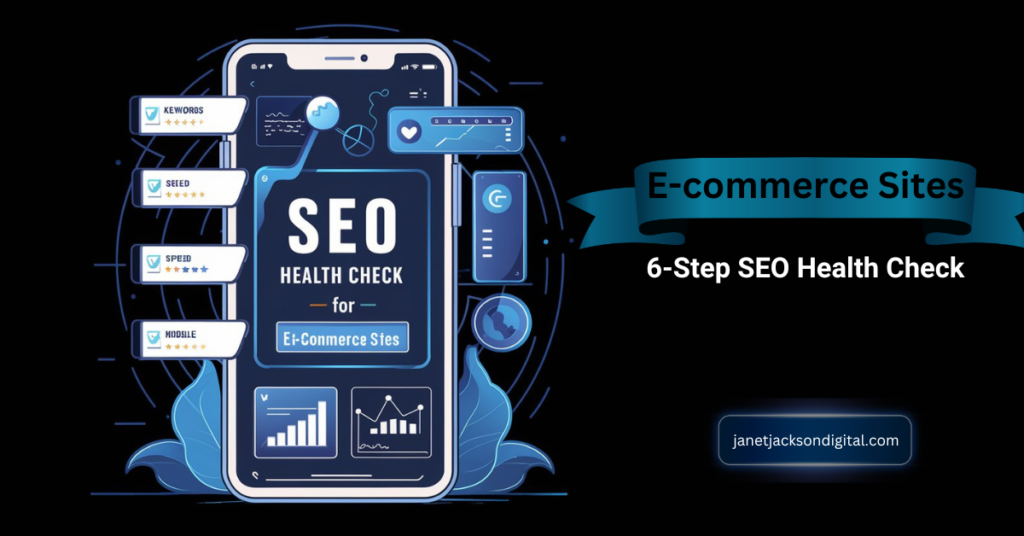Last Updated on June 23, 2025 by janetjacksondigital

E-commerce Sites
In order to increase quality visitors and online purchases, e-commerce businesses must prioritize search engine optimization, or SEO. But given how quickly Google is updating its algorithms and the ongoing emergence of new best practices, it can be difficult for e-commerce companies to keep up with everything that affects their organic ranks and overall performance.
In addition to optimizing on-page SEO through product page content, titles, alt text, and more, we will cover technical aspects such as site architecture, speed, and mobile optimization; building high-quality backlinks via outreach, influencers, and content; enhancing listings with rich snippets; tracking keyword rankings to prioritize efforts; and promoting conversion rate optimization.
This post will walk you through a thorough 6-point SEO health check designed with e-commerce in mind.
By using this methodology, you may audit the essential components of the SEO foundation for your e-commerce website and take the required steps to manage the optimization that you can control.
Link-Building Outreach: Tried-and-True Strategies for Effective Relationship
Link building is one search engine optimization technique that improves your search engine rating. Link popularity is a major factor used by search engine algorithms to determine how relevant a page is. A website with a significant amount of connections suggests that its content is valuable. Creating internal and external links improves your website’s visibility. Connecting your website with links also makes it easier for search engines like Google to crawl it.
The Top 6 Crucial Steps in an SEO Health Check
Step 1: Audit the technical SEO components.
The first step in performing an e-commerce SEO health check is to assess the technical underpinnings, which have a significant impact on search visibility and ranks. Make sure your site is fast, accessible, and has good infrastructure before adding content and links.
Examine these crucial technical components:
Website Design
Users and bots can traverse your e-commerce site more easily if it has a logical site architecture with sensible URL structures and pages. Make sure the levels in your product categories and filters make sense and lead visitors toward completing a purchase.
Steer clear of really complicated navigation. Use a site crawler tool to check the architecture of the website for broken links or pages that return 404 errors.
Page Speed
Google now considers page speed to be a significant ranking element in order to promote websites with the best user experience. Use internet resources to test your website, such as Think With Google’s Test My Site and Google PageSpeed Insights. Check the load times of your homepage and important product pages on desktop and mobile devices.
Aim for a load speed of less than three seconds by eliminating clunky plugins, compressing files, reducing redirects, optimizing graphics, and enabling browser caching. Faster pages translate into happier users.
Adaptability to Mobile
More than 65 percent of online sales originate from mobile devices. Perform manual spot inspections on different goods and pages. Verify using several mobile-friendliness tests that text, images, and CTA buttons resize adequately without requiring horizontal scrolling.
Prioritize developing a responsive design or building a separate m.dot mobile website with comparable content if it isn’t mobile-friendly.
SSL Certificate (Secure Socket Layer)
Secure checkout transactions over “https” and data encryption are made possible by an SSL certificate. Additionally, it conveys security and confidence to customers and gives a positive signal to search engines.
Site-wide pages should be protected by SSL, not simply cart and checkout pages. Install a certificate right away, or use Qualys SSL Labs to assess how strong your present SSL installation is.
Sitemaps in XML
Search engines can more readily crawl your dynamic product inventory with the use of XML sitemaps. Use the Google Search Console to submit daily product inventory feeds and simple XML sitemaps for each product category.
This guarantees that new items are indexed on time.
The Robots.txt file
Search bots are instructed on what they can and cannot access via your robots.txt file. Unless it involves confidential assets, you usually want everything on an e-commerce site to be searchable.
To make sure you are not inadvertently preventing categories from being crawled, audit your robots.txt file with Screaming Frog or DeepCrawl. By addressing these technological problems up front, you may advance the basics that are directly related to rankings and revenue by optimizing pages and developing linkages.
Step 2: Improve the On-Page SEO Components
After auditing the technical SEO underpinnings, evaluate the on-page components that make up each product listing and page on the website. When these essential elements are optimized, relevant searches are more effectively targeted and click-through rates are increased when ranked.
Optimize the following with caution:
Tags for titles
In search listings, title tags show up as clickable link text. Product names should be no more than 60 characters, with e-commerce brand names coming last and key keywords appearing first. Create attention-grabbing, customer-focused titles that make people click.
Sweet Box – Decadent Gourmet Sweets from Margie’s Sweets is one such example.
Metadata Synopses
In search results, the page content is summarized by the meta description. Use 155 characters or less to accurately describe the product in order to increase click-through rates. Don’t overstate statements while using sales messaging and captivating adjectives.
Headings Labels
Proper header tags, such as H1, H2, and H3, aid in organizing material for search engines and website users. Make sure every page has a single principal product name (H1).
Divide long descriptions into manageable sections with callouts for the descriptive headings that highlight important elements like features, shipping information, maintenance guidelines, and more.
File names for images and alt text
Rename the filenames of product images to reflect the image’s target product keywords. Instead of using general statements, describe the image in the alt text element. This makes image context more understandable to search engines.
Density, Length, and Content
Every product description ought to be no less than 250 words, written in an engaging, benefit-driven language, and offer enough information for buyers.
When appropriate, incorporate target keywords; nevertheless, do not overoptimize. Optimizing these components has a big impact on conversion rates and on-page SEO power.
Step 3: Create Excellent Backlinks
One of the most powerful markers for search engine results is still backlinks. In order to gain “votes” for their authority and relevancy, e-commerce websites should aggressively cultivate links from related websites.
However, stay away from low-quality connections; instead, concentrate on obtaining editorial backlinks that have been rightfully provided by websites wishing to cite your work.
The following are some efficient backlink-building techniques for e-commerce:
Outreach to Bloggers and Influencers
Determine well-known bloggers and influencers in the market for your goods. You can establish collaborations by exchanging information and establishing connections on social media. In exchange for reviews, provide free product samples or special prices on related products. Reviews that are published and include links to your online business are quite beneficial.
Programs for Affiliate Marketing
Affiliate Marketing pay a tiny revenue-sharing commission to third-party websites that refer new clients to you.
Provide affiliates with substantial incentives to sign up and market your items through blog posts, videos, social media shares, etc. You both make more money the more sales they generate.
- ⏩Read Also : 10 Affiliate Marketing Side Hustle Ideas for 2024
Promoted Guest Articles
Write informative, interesting guest posts for specific websites with a lot of traffic and domain authority related to your product niche.
Make sure the material in guest posts is useful to the site’s readers. Ask for a short bio in return, mentioning your store as the author and including a link.
Skyscraper Method
The “skyscraper technique” entails creating even more valuable and engaging content to outrank already-existing high-performing material. Find resources that are well ranked for popular product phrases, then write excellent content related to those same terms.
Reach out to websites that link to the outdated resource and offer them your new manual, comparison, or reviews in exchange for them changing the link to point to your updated version. In order to create more effective and pertinent backlinks for your website, this makes advantage of websites that currently link to excellent resources in your industry.
By using a variety of reliable sources, you can diversify your backlink acquisition techniques and avoid being overly dependent on any one source. Combine some generic anchor text links with some branded anchor text connections. Track changes in fresh links with rank-tracking software.
Using Rich Snippets in Step Four
Adding structured data markup to your product pages is the first step. This entails adding product description JSON-LD, RDFa, or schema.org microdata. You must provide the name, description, image, and price, at the very least.
Using the Bread crumb List schema, add breadcrumb markup to the website next. This facilitates the understanding of the category hierarchy by search engines and the position of a page within it:
Product reviews can also be annotated with the review schema. This makes it possible for the text, author, and review rating to be shown prominently in search results.
This will provide you with an error check and a preview of your markup as rich snippets. Before submitting your website to Google Search Console so that the pages can begin to be indexed, correct any problems.
You can directly display product photos, ratings, pricing, and more in Google search results by using properly formatted rich snippets. This can increase click-through rates and provide search engines with important information without requiring users to visit your website.
Step 5: Monitor Search Engine Results
Finding the crucial terms and phrases that you wish to rank for is the first step. When looking for the things you sell, they should be terms that your target buyers are likely to search for. To find the most common search queries, analyze your site’s statistics and utilize keyword research tools like Google Keyword Planner.
After you’ve made your list, arrange the keywords according to priority. Ranking for the high-volume, high-conversion keywords that generate a lot of traffic and sales should be your primary priority.
Setting up tracking in the Google Search Console is the next step. Make sure you are the owner of the website, then submit your sitemap so that it gets indexed. Add the high-priority keywords you wish to monitor under Performance. The data pertaining to the current rankings will be displayed.
Additionally, use third-party SEO tools like as Moz, Ahrefs, or SEMrush to set up rank tracking. These provide you with additional ranking information, such as the top 10 competitors for every keyword. Most have historical data and rank checks.
Step 6: Optimization of Conversion Rate
Setting up tracking is the first step in obtaining the data required for optimization. To measure important metrics, install Google Analytics and put an e-commerce tracking code throughout the website:
- Sources of traffic
- Rates of bounces
- Each session’s pages
- Views of product and category pages in a single session
- Boost purchases and carts
- Drop-off in the conversion funnel
Install heat mapping software as well, such as Microsoft Clarity, Mouseflow, or Hotjar, to observe on-page behavior.
Next, set a benchmark for conversion rate so you can measure your progress. Divide the total orders by the total number of site sessions to determine your current site-wide rate. Additionally, divide it up by device kind, marketing channel, and other cuts.
Typical strategies for e-commerce optimization consist of:
- Streamlining menus and navigation.
- Enhancing the descriptions of products.
- Include trust symbols and evaluations.
- Displaying assurances and security credentials.
- Suggesting supplementary goods.
- Presenting savings messaging or coupons.
- Permitting guest check-outs.
- Pre-filling the fields on forms.
Give priority to updates that address several problems users have in heatmaps and session recordings. After making improvements, track the outcomes for 30 to 90 days before evaluating performance.
In summary
This all-inclusive 6-step SEO health check provides a detailed road map for identifying issues, concentrating on short wins, and pursuing a successful long-term e-commerce SEO plan.
Keep abreast of any updates to Google’s recommended practices. To further diversify and scale business, leverage other important digital marketing channels like social media and sponsored search.
This methodology’s ongoing optimization will help your website maintain its organic presence and turn users into satisfied, returning clients.
FAQ
To what extent is SEO relevant to eCommerce websites?
Indeed, SEO efforts have an effect on e-commerce website conversions. Through improving user experience and optimizing the website for pertinent keywords, SEO helps draw in targeted traffic and boost conversions. Having a high search engine rating increases credibility and trust. Purchase decisions are positively impacted by this.
What is an SEO description for e-commerce?
UX and SEO for e-commerce go hand in hand.
SEO enhances the user experience (UX) of your e-commerce website by connecting with customers wherever they are in the consumer journey. Stated differently, search engine optimization (SEO) is a tool that helps customers find what they need and get where they want to go in addition to driving traffic to your website.To what extent is SEO relevant to eCommerce websites?
Indeed, SEO efforts have an effect on e-commerce website conversions. Through improving user experience and optimizing the website for pertinent keywords, SEO helps draw in targeted traffic and boost conversions. Having a high search engine rating increases credibility and trust. Purchase decisions are positively impacted by this.
What is an SEO description for e-commerce?
UX and SEO for e-commerce go hand in hand.
SEO enhances the user experience (UX) of your e-commerce website by connecting with customers wherever they are in the consumer journey. Stated differently, search engine optimization (SEO) is a tool that helps customers find what they need and get where they want to go in addition to driving traffic to your website.What advantages does SEO for e-commerce offer?
Ecommerce SEO’s advantages
⏩Enhanced Branding. Companies that prioritize their clients are
⏩more like to be successful.
➡More Sales & Traffic.
➡A higher rate of conversion.
➡Increased Credibility.
➡Increased Search Engine Rankings.
➡A higher level of customer engagement.
➡High-Grade Information.
➡Improved User Experience.In an e-commerce setting, how is SEO success measured?
The Most Vital SEO KPIs to Monitor
1. Natural Traffic.
2. Rate of Conversion.
3. Rate of Bounces.
4. Page Positions.
5. Essential Web Content.
6. Backward connections.
7. Return on Investment.What is SEO in the context of e-commerce and digital marketing?
When a website’s pages are more easily found, relevant, and popular for user search queries, search engines will rank them higher. This makes the website’s pages easier to locate, more popular, and relevant for user search queries—all of which improves the website’s ranking in search engines.

My name is Janet Jackson Seo and I work as a SEO Expert. I appreciate the process of developing an innovative approach and employing logic, particularly when it concerns future studies and SEO optimization. As an SEO expert I have known how to set up SEO campaigns fully and how to monitor their achievements.





